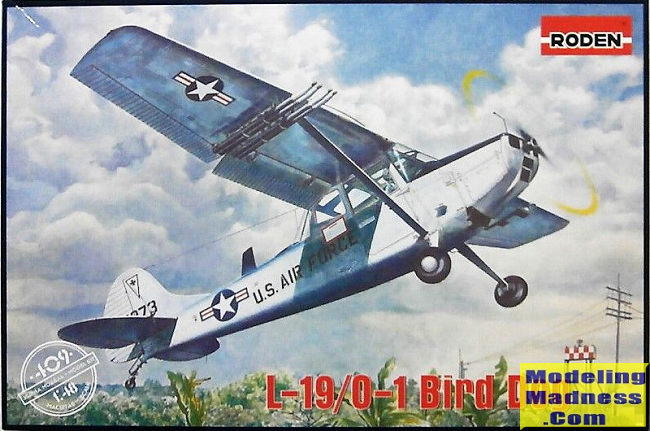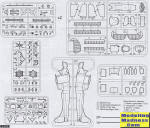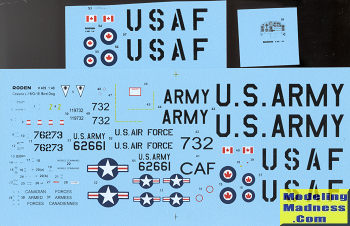
Roden 1/48 L-19/0-1 'Bird Dog'
| KIT #: | 409 |
| PRICE: | $37.00 delivered from Ukraine |
| DECALS: | Three options |
| REVIEWER: | Scott Van Aken |
| NOTES: |

| HISTORY |
The United States Department of Defense (DOD) ordered 3,200 L-19s that were built between 1950 and 1959, entering both the U.S. Army and U.S. Marine Corps inventories, initially designated as OE-1s in the Marine Corps until all US military aircraft designations were standardized in 1962. The aircraft were used in various utility roles such as artillery spotting, front line communications, medevac and training.
In 1962, the Army L-19 and Marine Corps OE-1 was redesignated the O-1 (Observation) Bird Dog and entered the war in Vietnam. During the early 1960s, the Bird Dog was flown by South Vietnamese (ARVN-Army Republic Vietnam/SVAF South Vietnamese Air Force), U.S. Army, and U.S. Marines in South Vietnam and later by clandestine forward air controllers (e.g., Ravens) in Laos and Cambodia. Because of its short takeoff and landing (STOL) and low altitude/low airspeed capabilities, the O-1 also later found its way into U.S. Air Force service as a Forward Air Controller (FAC) aircraft for vectoring faster fighter and attack aircraft and supporting combat search-and-rescue operations recovering downed aircrews.
During the Vietnam War the Bird Dog was used primarily for reconnaissance, target acquisition, artillery adjustment, radio relay, convoy escort and the forward air control of tactical aircraft, to include bombers operating in a tactical role.
Supplementing the O-1, then gradually replacing it, the USAF switched to the Cessna O-2 Skymaster and North American OV-10 Bronco, while the U.S. Marine Corps took delivery of the OV-10 to replace their aging O-1s. Both were faster twin-engined aircraft, with the OV-10 being a turboprop aircraft, but the U.S. Army retained the Bird Dog throughout the war with up to 11 Reconnaissance Airplane Companies (RACs) deployed to cover all of South Vietnam, the DMZ and the southern edge of North Vietnam. Its quieter noise footprint, lower speed, tighter maneuverability, short runway ability and better visibility (even to the rear) kept it highly valued by the ground units it supported and highly feared by enemy units it flew over. The last U.S. Army O-1 Bird Dog was officially retired in 1974.
During the course of the Vietnam War, 469 O-1 Bird Dogs were lost to all causes. The USAF lost 178, the USMC lost 7, and 284 were lost from the U.S. Army, South Vietnamese Forces, and clandestine operators. Three Bird Dogs were lost to enemy hand-held surface-to-air missiles (SAMs).
Two O-1 Bird Dogs were loaned to the Australian Army's 161 Reconnaissance Flight operating out of Nui Dat in Phuoc Tuy province. One was lost to ground fire in May 1968, killing 161's commanding officer. Another Bird Dog was built by this unit's maintenance crew, using aircraft sections salvaged from dumps around Vietnam. It was test-flown and later smuggled back to Australia in pieces, contained in crates marked as "aircraft spares". This aircraft now resides in the Museum of Army Flying at the Army Aviation Center at Oakey, Queensland.
As the USAF phased out the O-1 in favor of the O-2 and OV-10, many O-1s in the United States were sold as surplus. During the 1970s and 1980s, Ector Aircraft remanufactured many as the Ector Mountaineer with their original powerplants, and as the Ector Super Mountaineer with the Lycoming O-540-A4B5.
| THE KIT |
 When
Roden brought out their 1/32 O-1 kit, it was felt it would be only a matter
of time before the 1/48 version would be released. So here it is and it
would be nice if they went to 1/72 with it as well. If you have seen or
built the larger scale version, then this will seem fairly familiar. The kit
has a complete engine which you'll need to built up to a certain level as it
is needed for the exhausts and the prop. Like the Minicraft Super Cub, the
engine cowling is a lot of parts if you want to display the airplane with
panels open. However, Roden makes no special bits to allow this so it is up
to you to devise hinges and such.
When
Roden brought out their 1/32 O-1 kit, it was felt it would be only a matter
of time before the 1/48 version would be released. So here it is and it
would be nice if they went to 1/72 with it as well. If you have seen or
built the larger scale version, then this will seem fairly familiar. The kit
has a complete engine which you'll need to built up to a certain level as it
is needed for the exhausts and the prop. Like the Minicraft Super Cub, the
engine cowling is a lot of parts if you want to display the airplane with
panels open. However, Roden makes no special bits to allow this so it is up
to you to devise hinges and such.  Instructions
are well done with color references using Vallejo paint. Three options are
provided. One is the box art plane which is allegedly in overall steel. This
is incorrect as the color used was ADC grey, FS 16473. Note that there is a
supplemental sheet included that includes the proper stencils for the USAF
on this plane. In the main sheet and the 1/32 kit, the A in USAF had the
stencil reversed. A very colorful overall orange plane based in Alaska with
the Army is included as well. The third option is a Canadian version in
overall olive drab. I would guess the OD on this is gloss. The decal sheet
is nicely printed with the addendum sheet taking care of any glitches. An
instrument panel decal is also included. My last Roden kit (which was
several years back) had decals that refused to work with setting solutions
and silvered rather badly. Hopefully, these are not the same. Fortunately
there are aftermarket.
Instructions
are well done with color references using Vallejo paint. Three options are
provided. One is the box art plane which is allegedly in overall steel. This
is incorrect as the color used was ADC grey, FS 16473. Note that there is a
supplemental sheet included that includes the proper stencils for the USAF
on this plane. In the main sheet and the 1/32 kit, the A in USAF had the
stencil reversed. A very colorful overall orange plane based in Alaska with
the Army is included as well. The third option is a Canadian version in
overall olive drab. I would guess the OD on this is gloss. The decal sheet
is nicely printed with the addendum sheet taking care of any glitches. An
instrument panel decal is also included. My last Roden kit (which was
several years back) had decals that refused to work with setting solutions
and silvered rather badly. Hopefully, these are not the same. Fortunately
there are aftermarket.
| CONCLUSIONS |
I know that quite a few folks were pleased to see this kit released. I would caution the buyer that you'll need to clean the sprues as my kit had quite a bit of mold release agent over the plastic. One thing I can pretty well guarantee, it will be a much nicer build that the previous Model USA kit in this scale, which was a real struggle. Generally available to your door for under $40.00
| REFERENCES |
https://en.wikipedia.org/wiki/Cessna_O-1_Bird_Dog
July 2019 Copyright ModelingMadness.com. All rights reserved.
If you would like your product reviewed fairly and fairly quickly, please contact the editor or see other details in the Note to Contributors.
Back to the Main Page Back to the Review Index Page Back to the Previews Index Page